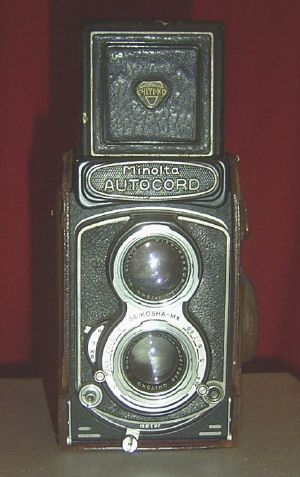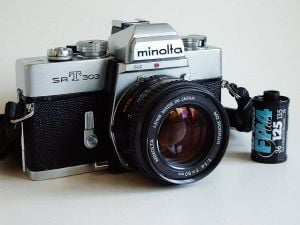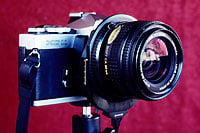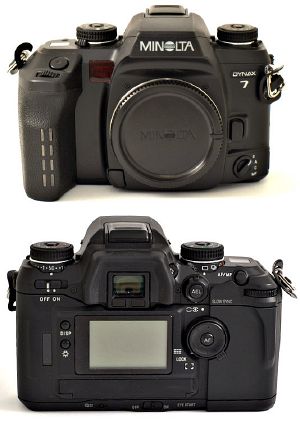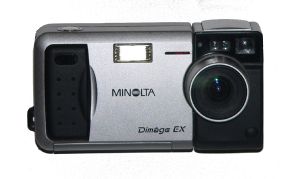Minolta
| Minolta XD-7 (XD-11, XD) | |
|---|---|
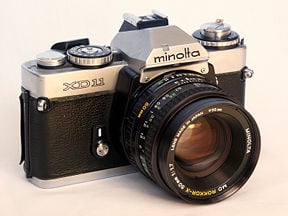
| |
| Type | 35 mm SLR |
| Lens mount | Minolta MD mount |
| Focus | Manual focus |
| Exposure | Shutter and Aperture priority autoexposure |
| Flash | Hot shoe only |
| Dimensions | 51 x 86 x 136 mm, 560 g |
Minolta Co., Ltd. was a Japanese worldwide manufacturer of cameras, camera accessories, photo-copiers, fax machines and laser printers. Minolta was founded in Osaka, Japan in 1928 as Nichi-Doku Shashinki Shōten (日独写真機商店; meaning Japanese-German camera shop). It is perhaps best known for making the first integrated autofocus 35 mm SLR camera system. It was not until 1933 that the brand name appeared on a camera, a copy of the Plaubel Makina simply called "Minolta".
In 2003, Konica Corporation merged with Minolta to form Konica Minolta.
On January 19, 2006, Konica Minolta announced that it was leaving the camera and photo business [1] and that it would sell a portion of its SLR camera business to Sony as part of its move to pull completely out of the business of selling cameras and photographic film. [2]
History
Milestones
- 1928: Kazuo Tajima established Nichi-Doku Shashinki Shōten (Japanese-German photo company; the precursor of Minolta Co., Ltd.).
- 1929: Marketed the Company's first camera, the "Nifcalette".
- 1937: The "Minolta Flex" is Japan's first twin-lens reflex camera.
- 1958: The Minolta SR-2 is Minolta's first single-lens reflex camera.
- 1959: The Minolta SR-1.
- 1962: John Glenn takes a specially modified Ansco-logo'd Minolta Hi-Matic camera into space aboard Freedom 7. The company changes its name to Minolta Camera Co., Ltd.
- 1966: The Minolta SR-T 101 SLR camera is Minolta's first with through-the-lens full aperture (TTL) light metering.
- 1972: Minolta signs an agreement to cooperate with Leica in SLR development.
- 1973: The Minolta CL is the first fruit of this agreement.
- 1976: The Leica R3 is introduced. Minolta produces the R3, R4, and R5 models in the Leica R series. Subsequent cameras are built in Germany by Leica themselves.
- 1981: Implementation of Minolta's invention and patent of TTL OTF Through The Lens Off The Film exposure metering: The Minolta CLE is the first 35 mm rangefinder camera to feature TTL metering and aperture priority auto-exposure. The Minolta X-700 manual-focus SLR is introduced; this model is sold until 1999 and is enormously successful. The Minolta XD-11 (Model E) is the first Minolta product branded with an updated logo in caps, which was in use until the 2003 merger with Konica.
- 1985: The Minolta Maxxum 7000 becomes the world's first truly successful autofocus SLR. Other manufacturers soon follow suit, but Minolta's innovation gives much sales success.
- 1987: Honeywell file lawsuit against Minolta for patent infringement over autofocus technologies.
- 1991: Minolta's innovative autofocus design was found to infringe on the patents of Honeywell, a U.S. corporation. After protracted litigation, Minolta in 1991 was ordered to pay Honeywell damages, penalties, trial costs and other expenses in a final amount of 127.6 million dollars (source: NY Times).
- 1992: Minolta finally settles out-of-court with Honeywell.
- 1994: The company changes its name to Minolta Co., Ltd. because it no longer is primarily a camera company.
- 1995: Introduction of the Minolta RD-175, an early 1.75 megapixel digital SLR camera.
- 1996: The Minolta Vectis camera is a completely new SLR system designed around the Advanced Photo System (APS) film format.
- 1998: The Minolta Maxxum 9 autofocus SLR is introduced. This system is targeted toward the professional photographer and has many features not duplicated by the competition.
- 2003: DiMAGE A1 introduced, replacing the DiMAGE 7HI. DiMAGE A1 final Minolta product branded prior to the Konica Minolta merger.
- 2004: Minolta and Konica officially merge to become Konica-Minolta Holdings, Inc.
- 2005: The company announces joint venture with Sony on CCD and CMOS technologies.
- 2006: Konica-Minolta announces it is discontinuing all film and digital camera production, ending a 78-year history as a camera manufacturer. Konica-Minolta Photo Image, Inc.'s (the camera business portion of Konica Minolta) asset regarding digital camera technology is transferred to Sony for continued development started from the joint venture.
Early cameras
Relying heavily on imported German technology, Nichi-Doku turned out their first product, a bellows camera called the Nifcalette, in March 1929. By 1937, the company reorganized as Chiyoda Kogaku Seikō, K.K. (Chiyoda Optics and Fine Engineering, Ltd.) and built the first Japanese-made twin-lens reflex camera, the Minoltaflex based on the German Rolleiflex.
In 1950, Minolta developed a planetarium projector, the first-ever made in Japan, beginning the company's connection to astronomical optics. John Glenn took a Minolta Hi-Matic rangefinder 35 mm camera aboard the spacecraft Friendship 7 in 1962, and in 1968, Apollo 8 orbited the moon with a Minolta Space Meter aboard.
In the late 1950s and 1960s, Minolta competed in the medium-format rollfilm camera market with the excellent Autocord series of TLR (twin lens reflex) cameras. Marketed at a time when other indifferent copies of the Rolleiflex TLR design were flooding the market, the Autocords soon acquired an enviable reputation for the high quality of their Rokkor optics.
Single lens reflex cameras
In the 1960s Minolta introduced its SR camera lines and later, the SR-T 35mm SLR camera series (cameras with the 'SR' designation equipped with through-the-lens metering) which are widely regarded as some of the most innovative single lens reflex (SLR) cameras of the era.[attribution needed] Although well-made, the SR series and the SR-T series were not as robust as the professional-level Nikon F or F2. Like the Canon Ftb, the Minolta SR/SRT design used sleeve bushings instead of bearings on its focal plane spindles, and had greater tolerances between working parts. This occasionally caused problems in very cold weather or extremely high-levels of use. Nevertheless, the cameras appealed to serious amateur photographers with their more affordable prices and high-quality optics.
From the late 1950s through the 1980s, Minolta was arguably the most innovative camera manufacturer - the first Japanese manufacturer to introduce a bayonet lens mount rather than a screw mount, the first manufacturer to introduce TTL metering with full aperture, and the first manufacturer to introduce multi-mode metering. They also introduced the first commercially-successful autofocus SLR line with the Maxxum series.
In 1972, Minolta drew up a formal cooperation agreement with Leitz. Leitz desperately needed expertise in camera body electronics, and Minolta felt that they could learn from Leitz's undoubted optical expertise. Tangible results of this cooperation were the Leica CL/Minolta CL, an affordable rangefinder camera to supplement the Leica M range. The Leica CL was built by Minolta, to Leica specifications. Other results were the Leica R3, which was in fact the Minolta XE-1 with a Leica lens mount, viewfinder and spot light metering system.
First 'program' focal plane shutter 35mm SLR: the XD-11
In 1977, Minolta introduced the XD-11, the first multi-mode 35 mm compact SLR to include both aperture and shutter priority in a single body. The XD-11 is considered by many to be the best manual-focus 35mm SLR Minolta ever produced, and the last serious attempt by Minolta to enter the professional and semi-professional 35mm SLR market until the Maxxum 9 in 1998. Elements of the XD11 design, called the XD7 in Europe, were utilized by Leitz for the Leica R4 camera.
Others regard the XM (XK in the Americas, X-1 in Japan), a rugged camera designed for the serious amateur and professional photographer dating from 1972, to be the quintessential Minolta. The XM / XK /X-1 Motor(the motorized version) may well be the most collectible Japanese 35 mm camera - in September 2004 an XM Motor of 1976 was sold for €2566, approximately 200% of its price back in 1976.
Minolta continued to offer 35mm MF SLR cameras in its X370, X-570, and X-700 from 1981, but slowly repositioned its cameras to appeal to a broader market. Minolta decided to abandon the high level of design and parts specification of its earlier XD/XE line. The new amateur-level X-570, X-700, and related models offered additional program and metering features designed to appeal to newer photographers, at a lower cost. The advanced vertical metal shutter design of the older cameras was rejected in favor of a cheaper horizontal cloth-curtain shutter, reducing flash sync to a very slow 1/60th second. Further cost savings were made internally, where some operating components were changed from metal to plastic. As Minolta's autofocus Maxxums were proving successful, Minolta invested fewer resources in its manual focus line as time progressed.
Minolta was quick to enter the highly competitive 35mm compact camera market in the 1980s. Transitioning from older rangefinder designs to 'point-and-shoot' (P&S)electronic, autofocus/autowind cameras was applauded by most camera buyers, but decried by those who missed the old Minolta quality. Minolta, like other major manufacturers faced with low-cost competition from elsewhere in Asia, found it difficult to build quality P&S cameras at a cost the consumer was willing to pay, and was forced to offshore production, gradually redesigning successive cameras to reduce cost and maintain profit margins.
Autofocus SLRs
In 1985, Minolta introduced a new line of autofocus (AF) SLR cameras. In North America, they used the name 'Maxxum', in Europe the cameras were called 'Dynax' and in Japan they were named 'Alpha'. They were Minolta's first line of automatic focus SLR cameras, and in fact the first commercially successful autofocus SLRs the world had seen.
With the Maxxum line, the heavy-duty metal bodies of earlier Minoltas were abandoned in favor of lighter and less expensive plastics. The Maxxum 7000, the most popular of the new Maxxums, introduced the innovation of arrow buttons for setting aperture and shutter speed, rather than a shutter speed dial on the body and an aperture ring on the lens. That way, the only control necessary on the lens is the manual focusing ring (plus the zoom ring in the case of zoom lenses).
The Maxxum 7000 had two 8-bit CPUs and six integrated circuits. A circuit on the lens relayed aperture information to the camera body, and the motor for autofocus was contained within the camera body. An LCD showed aperture, shutter speed and film frame count. The 7000 had TTL phase-detection focusing and metering, autoexposure and predictive autofocus. All Maxxum cameras use the Minolta 'A' autofocus lens mount, and earlier manual-focus Minolta MC and MD lenses are incompatible with the new AF cameras.
Unfortunately for Minolta, its autofocus design was found to infringe on the patents of Honeywell, a U.S. corporation. After protracted litigation, Minolta in 1991 was ordered to pay Honeywell damages, penalties, trial costs and other expenses in a final amount of 127.6 million dollars (source: NY Times).
After the 4-digit Maxxum i line which included the 3000i, 5000i, 7000i and 8000i came the 1-digit Maxxum xi line, followed by the 3-digit si line, the 1-digit line without letters (Alpha/Dynax/Maxxum 3, 4, 5, 7, 9), and finally, the Maxxum 50 (Dynax 40) and Maxxum 70 (Dynax 60).
APS format cameras
Minolta also invested heavily in APS (Advanced Photo System) film-format cameras, most notably with the Vectis line of SLR cameras beginning in 1996. APS later proved to be a technological dead end as the cameras did not sell as hoped. Digital photography was entering the marketplace, and Minolta eventually discontinued all APS camera production.
Other developments
Minolta introduced features that became standard in all brands a few years later. Among standardized features that were first introduced on Minolta models are: multisensor light-metering coupled to multiple AF-sensors; automatic flash balance system; wireless TTL flash control; TTL controlled full-time flash sync; speedy front and rear wheels for shutter and aperture control. Special features introduced by Minolta are: interactive LCD viewfinder display; setup memory; expansion program cards (discontinued); eye-activated startup; infrared frame counter.
Merger with Konica
In an effort to strengthen market share and acquire additional assets in film, film cameras and optical equipment, Minolta merged with another long-time Japanese camera manufacturer, Konica Ltd., in 2003. The new corporation was called Konica-Minolta Ltd.
Until Konica-Minolta announced their withdrawal plan in 2006, K-M made Maxxum/Dynax digital and film-based cameras (retaining the different names in the different markets), improving the design while maintaining the basic concepts. The Maxxum 4 is a low-priced 35mm SLR with an A-type bayonet mount, built-in flash, autoexposure, predictive autofocus, electronically controlled vertical-traverse focal plane shutter, through-the-lens (TTL) phase-detection focusing and metering. In advertising literature, Minolta claimed that the Maxxum 4 was the most compact 35 mm AF SLR, and the second fastest at autofocusing, while the Maxxum 5 was the fastest at autofocusing. These cameras were, however, intended for the consumer end of the market.
Minolta made one last attempt to enter the serious amateur and professional market with the Maxxum (Dynax) 9 in 1998, followed by the Maxxum 7 in 2000, which used a full LCD readout on the rear of the camera. Though well received by the photographic press, the 7 and 9 did not sell to expectation or achieve any significant breakthrough with their intended customer base, who had largely gravitated to Canon or Nikon brands. All of these cameras were eventually discontinued in favor of the less-expensive Maxxum 50 and 70, which were sold under the Minolta name until 2006, when Konica-Minota ceased production of all film cameras.
Digital cameras
Minolta has a line of digital point and shoot cameras to compete in the digital photography market. Their DiMage line includes digital cameras and imaging software as well as film scanners.
Minolta created a new category of 'ZSLR' or fixed zoom-lens SLR-type cameras with the introduction of the DiMage 7. Designed for use by people familiar with 35mm single-lens-reflex or SLR cameras, without the added cost or complication of interchangeable lenses or optical reflex viewfinders, the DiMage incorporated many of the features of a higher level film camera with the simplicity of smaller compact digicams. The camera had a traditional zoom ring and focus ring on the lens barrel, and was equipped with an electronic (EVF) viewfinder rather than the direct optical reflex view of an SLR. It added other features such as a histogram and the cameras were compatible with Minolta's flashes for modern film SLRs.
However, the DiMage 7 (including the DiMAGE A1, A2, and A200) and similar 'ZSLR' cameras were not really adequate substitutes for professional SLR cameras, and initially there were many reports of slow autofocus speed and various malfunctions (this has surfaced where a Sony-designed CCD chip would malfunction, rendering the camera useless. Minolta, however, issued a CCD alert and fixed faulty units free of charge; after Konica Minolta's withdrawal from the photo business, Sony has taken over the CCD alert). Minolta later innovated in this line by being the first manufacturer to integrate a mechanical anti-shake system (Minolta's Anti-Shake is based inside the camera body as opposed to the camera lens - common with Canon EF and Nikon DX lenses).
In January 2002 Minolta again created a new category of camera, introducing the Minolta Dimage X, an ultra compact digital with a 3x folded zoom lens. With the folded approach, no moving parts of the lens are external to the camera. Instead a 45 degree mirror bounces light to a conventional zoom lens safely tucked inside the camera body. Fast startup times are one potential benefit of this design (since nothing needs to extend), but slow focus and shutter lag times marred the advantage of this innovation.
Digital SLRs
After the merger with Konica, it was thought by many that Minolta would quickly enter the digital SLR market, a belief that proved premature.
Although Minolta had launched the first digital SLR system as early as 1995, the RD-175 – a 1.75 megapixel camera based on the Maxxum 500si – this camera was never successful and in 1998, this camera was superseded by the RD3000, a 3 megapixel SLR based on the lens mount of the Vectis APS SLR camera line, which was equally unsuccessful and short-lived.
While Minolta was the inventor of the modern integrated AF SLR, it took Konica-Minolta a long time to enter the digital SLR market, a delay that may have proved fatal. K-M was the last of the large camera manufacturers to launch a digital SLR camera (Maxxum/Dynax 5D and 7D) using the 35 mm AF-mount. Popular with many owners, the DSLR cameras appeared to suffer from a lack of marketing and promotion, certainly in comparison to the "two majors" Nikon and Canon. During July 2005, K-M and Sony negotiated on a joint-development of a new line of DSLR cameras, where it was believed that Konica-Minolta and Sony would market their DSLR line to the masses (much like the joint-marketing and development of Pentax and Samsung K10/GX10 DSLRs).
On January 19, 2006, K-M announced that all DSLR production would continue under Sony's management; DSLR camera assets were transferred to Sony during the Konica-Minolta withdrawal phase until March 31, 2006, where technical support for these cameras (primarily Konica-Minolta's other digital cameras) was assumed by Sony, who announced the first Konica-Minolta-based Sony SLR - the Alpha A100 - on June 5 2006.
See also
- List of Minolta products
- Category:Minolta cameras
- Sony α Sony Alpha DSLR
ReferencesISBN links support NWE through referral fees
- Photoxels.com. Brief History of Minolta. Retrieved on November 29, 2005.
- Sony Corporation announced a new brand for digital Single Lens Reflex (SLR) cameras which Konica Minolta Photo Imaging, Inc has developed
es:Minolta
fr:Minolta
ko:미놀타
it:Minolta
ja:ミノルタ
ru:Minolta
sv:Minolta
zh:美能達
Credits
New World Encyclopedia writers and editors rewrote and completed the Wikipedia article in accordance with New World Encyclopedia standards. This article abides by terms of the Creative Commons CC-by-sa 3.0 License (CC-by-sa), which may be used and disseminated with proper attribution. Credit is due under the terms of this license that can reference both the New World Encyclopedia contributors and the selfless volunteer contributors of the Wikimedia Foundation. To cite this article click here for a list of acceptable citing formats.The history of earlier contributions by wikipedians is accessible to researchers here:
The history of this article since it was imported to New World Encyclopedia:
Note: Some restrictions may apply to use of individual images which are separately licensed.
